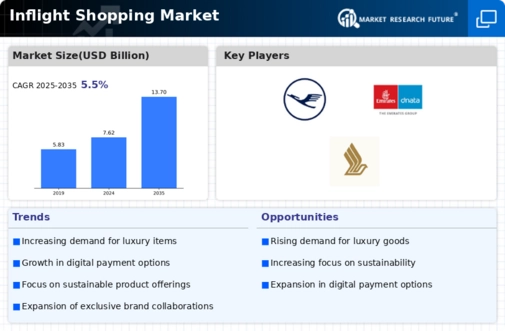Market Trends
Key Emerging Trends in the Inflight Shopping Market
The inflight shopping market has experienced notable trends, reflecting the evolving preferences of air travelers and the increasing focus of airlines on enhancing the passenger experience. Inflight shopping has transformed from a limited selection of duty-free items to a dynamic retail environment, offering a diverse range of products and experiences. One significant trend is the integration of technology to streamline the inflight shopping process. Airlines are leveraging onboard Wi-Fi and mobile apps to create digital shopping platforms, allowing passengers to browse, select, and purchase products directly from their seats. This digitalization not only enhances convenience for travelers but also opens up new opportunities for airlines to personalize offers based on passenger preferences and behavior.
Another noteworthy trend is the expansion of product offerings beyond traditional duty-free items. Inflight shopping catalogs now encompass a wide array of products, including electronics, fashion, cosmetics, and exclusive collaborations with luxury brands. Airlines are strategically curating their inflight retail selections to cater to diverse passenger demographics and preferences, transforming the inflight shopping experience into a more retail-like environment. This trend aligns with the broader shift toward providing passengers with a curated and premium travel experience.
Collaborations between airlines and renowned brands are becoming increasingly common in the inflight shopping market. These collaborations go beyond traditional duty-free partnerships, with airlines partnering with fashion houses, beauty brands, and tech companies to offer exclusive and limited-edition products to passengers. Such collaborations not only enhance the inflight shopping experience but also contribute to brand positioning and customer loyalty for both the airline and the participating brands.
The concept of pre-ordering and home delivery has gained traction in the inflight shopping market. Passengers can browse inflight shopping catalogs before their journey, pre-order desired items, and have them delivered to their homes upon arrival. This trend addresses the limitations of onboard inventory and allows passengers to access a more extensive selection of products. Additionally, it offers airlines an opportunity to extend the shopping experience beyond the confines of the aircraft, creating a seamless and convenient retail experience for travelers.
Personalization has emerged as a key focus in the inflight shopping market. Airlines are leveraging data analytics and passenger profiles to tailor inflight retail offerings to individual preferences. By understanding the shopping behaviors and preferences of their passengers, airlines can offer personalized product recommendations and promotions, creating a more engaging and relevant shopping experience. This trend reflects the broader industry shift toward enhancing customer satisfaction and loyalty through personalized services.
The inflight shopping market is also witnessing an increased emphasis on sustainability and eco-friendly products. Airlines are incorporating environmentally conscious brands and products into their inflight retail offerings, responding to the growing consumer demand for sustainable and responsibly sourced goods. This trend aligns with the aviation industry's broader efforts to reduce its environmental footprint and promote sustainable practices.
In response to the challenges posed by the COVID-19 pandemic, the inflight shopping market has seen a rise in contactless payment options and digital transactions. Airlines are encouraging passengers to use electronic payment methods and onboard digital platforms to minimize physical contact during the shopping process. This trend not only enhances hygiene and safety but also aligns with the broader global shift toward cashless transactions.






Leave a Comment